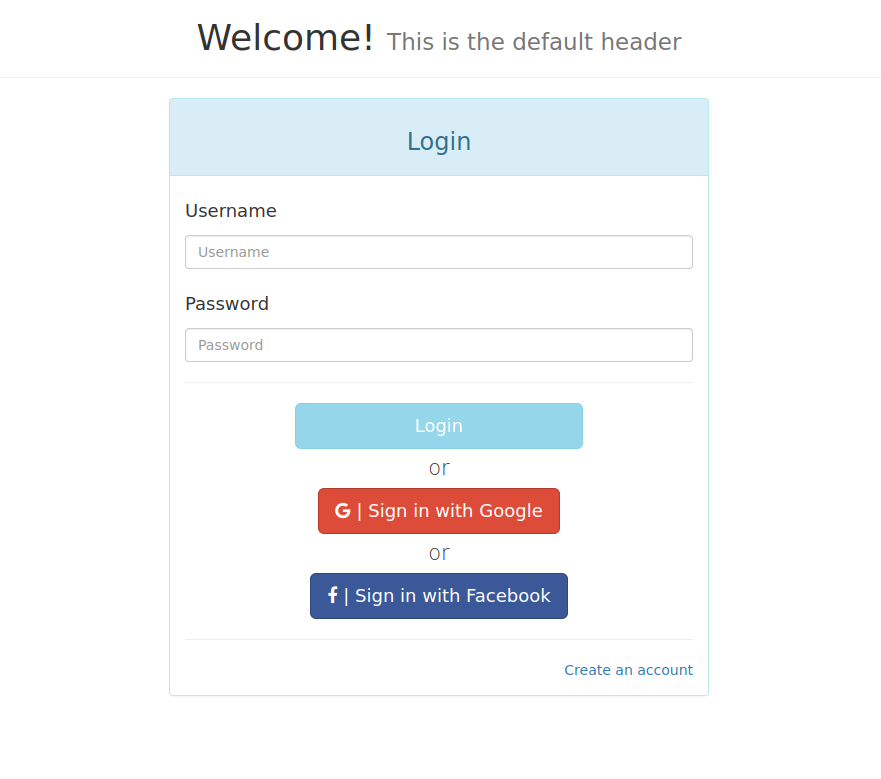A user management system, consisting of a Django (DRF) server exposing a REST API and an Angular single page app consuming it.
It is meant to be used as a backbone for any DRF + Angular project requiring user authentication, including social authentication.
- Completely separated Server and Client
- User registraton, authentication and basic management
- Django OAuth Toolkit is used as an OAuth2 provider
- User registration with form validation and async validators
- User authentication, update & delete
- Social sign in with Facebook and Google
- Google sign in implements authorization code grant, which allows for server calls to Google's API.
- Configurable routing system for the Client
Check out a sample website for appointment scheduling built on top of it.
If you want the source code for this website, it's available here.
Note that social authentication is disabled for the demo!
- Overview
- Technologies
- Setup and Configuration
- Additional Configurations
- Testing
- Deployment considerations
- Further development notes
- License
Client is provided as an NPM package. Its dependencies are:
- Angular
- Bootstrap
- JQuery
- angular-bootstrap-alert-modals
- angular-route
- angular-oauth2
- angular-resource
- angular-cookies
- bootstrap-social
Developer dependencies include:
- http-server
- angular-mocks
- Karma + Jasmine for testing
- Istanbul for code coverage
The main functionality is provided by the Django app usersystem.
Server requirements include:
- Python (3.5)
- Django
- Django Rest Framework
- django-cors-middleware, for managing CORS
- Django OAuth Toolkit, as an OAuth2 provider
- Django rest-framework Social Oauth2, for social authentication
- requests
After cloning the repository, both the server and client need to be configured:
- Go into the
serverdirectory - Create a virtualenv:
virtualenv env - Activate it:
source env/bin/activate - Install requirements from requirements.txt:
pip install -r requirements.txt cdintoproject/secrets.pycontains the secret keys for social authentication and since it is ignored by git, needs to be created fromtemplate.secrets.py. Runcp usersystem/template.secrets.py usersystem/secrets.py.- Next, sync your database with
python manage.py migrate - Create a superuser with
python manage.py createsuperuser - Try to run the test suite with
python manage.py test. If everything is alright you shouldn't see any errors. - You can now start the server using
python manage.py runserver - Go to http://localhost:8000/admin and login with the superuser you created
- You will now be able to create client application:
- Go to
DJANGO OAUTH TOOLKIT -> Applications -> ADD APPLICATION - Set the
Userproperty to your superuser - Set
Client typetoPublic - Set
Authorization grant typetoResource owner password-based - Set
Nameto whatever you like your client name to be. - Copy the
Client id, you'll need it in a moment. - Save it
- Now go to
server/project/usersystem/settings.pyand paste the Client id intoLOCAL_OAUTH2_KEY. You'll also need to update it client-side in a minute, but the server is now configured.
- Go into the
client/directory - Install all dependencies with
npm install - Go to
app/configs.js. You'll need to setLOCAL_OAUTH2_KEYhere as well. - Client is now configured! Try to run the tests:
npm test. You shouldn't see any errors - Start serving the client with
npm start
Now, you should be able to go to http://localhost:8001 and see the client.
However, in order to get the social authentication working, some additional configuration is required.
To get Google sign in working, OAuth2 KEY and SECRET pair must be obtained from Google. These values must then be placed in server/project/usersystem/secrets.py. The key must also be available to the client, so go to client/app/configs.js and place it in GOOGLE_CLIENT_ID.
To get it working, KEY and SECRET pair must be obtained from Facebook. These values must then be placed in usersystem's server/project/usersystem/secrets.py. The key must also be available to the client, so go to client/app/configs.js and place it in FACEBOOK_CLIENT_ID.
By default, the system allows an username or password to be between 6 and 80 symbols. To change those defaults go to the respective constants in server/project/usersystem/settings.py and client/app/configs.js and update both files to the same values.
Client's routing configuration is stored in client/app/routing.js. Right now /login and /home are required as default routes for unauthenticated and authenticated users, respectively. Any number of other routes can be defined in window.routes in the same way (using the Route factory provided there).
By default (Recommended) the server issues access tokens with lifetime of 600 seconds. To change that value go to server/project/settings.py and update ACCESS_TOKEN_EXPIRE_SECONDS. You must also change the value of AUTO_REFRESH_TOKEN_INTERVAL_SECONDS in client/app/configs.js, so that the client knows how often to ask for a renewal.
npm test is the command for running the tests. Coverage report is then generated at coverage/.
python manage.py test runs the test suite.
Apart from the standard deployment checklist for django projects, here are some project-specific notes on deployment:
-
Since django-cors-middleware is used, it needs to be configured to allow CORS
-
In
client/app/configs.js:BASE_URLneeds to point to the serverHTTPSmust be set totruewhen using HTTPS.DEBUGmust be set tofalseto turn off console logs
The current mechanism for detecting duplicate emails when signing in through a social account is a bit messy (Look at pipeline.py as well as loginPanel.js's way of reporting it). A better way of handling this exception must be implemented.
Client should be able to infer the lifetime of the server's access tokens when issued and configure AUTO_REFRESH_TOKEN_INTERVAL_SECONDS accordingly by itself.
Copyright 2016 Simo Iliev
This program is free software: you can redistribute it and/or modify it under the terms of the GNU General Public License as published by the Free Software Foundation, either version 3 of the License, or (at your option) any later version.
This program is distributed in the hope that it will be useful, but WITHOUT ANY WARRANTY; without even the implied warranty of MERCHANTABILITY or FITNESS FOR A PARTICULAR PURPOSE. See the GNU General Public License for more details.
You should have received a copy of the GNU General Public License along with this program. If not, see http://www.gnu.org/licenses/.
